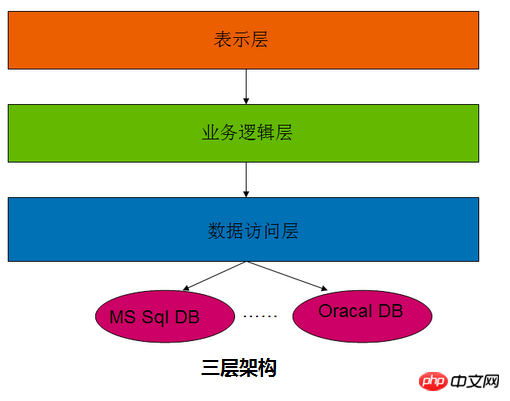
Detailed graphic explanation of this articlepythonThree-tierArchitecture
Three-tier architecture (3-tier architecture) Usually The three-tier architecture in the sense is to divide the entire business application into:
Presentation layer (Presentation layer), Business Logic Layer (Business Logic Layer), Data Access Layer (Data access layer).
#The purpose of distinguishing levels is the idea of "high cohesion and low coupling".
High cohesion and low coupling is a concept in software engineering and a standard for judging the quality of a design. It is mainly object-oriented design, mainly based on the cohesion of classes. Whether the sex is high and the degree of coupling is low.
Cohesion is how closely the elements in a module are combined with each other. High cohesion is how closely the elements in a module are combined with each other.
The so-called high cohesion means that a software module is composed of highly related codes and is only responsible for one task, which is often referred to as the single responsibility principle.
Coupling: A measure of the degree of interconnection between different modules within a software structure (coupling is also called inter-block connection. It refers to a measure of the closeness of the interconnection between modules in a software system structure.
The closer the connection between modules, the stronger the coupling, and the worse the independence of the module. The level of coupling between modules depends on the complexity of the interface between modules. , the method of calling and the information passed.)
For low coupling, the superficial understanding is:
A complete system, as far as possible between modules. to make it exist independently.
In other words, let each module complete a specific sub-function independently as much as possible.
The interfaces between modules should be as few and simple as possible.
If the relationship between two modules is relatively complex, it is best to consider further module division first.
This is conducive to modification and combination.
Three-tier architecture, as shown below:

2. Business logic layer (BLL): operations for specific problems, which can also be said to be operations on the data layer and processing of data business logic.
3. Data Access Layer (DAL): The transactions done by this layer directly operate the database, for data addition,
deletion, modification, search, etc.

#coding:utf8
from utility.sql_helper import MySqlHelper
class Admin(object):
def init(self):
self.helper = MySqlHelper()
def Get_One(self,id):
sql = "select * from userinfo where id = %s"
params = (id,)
return self.helper.Get_One(sql, params)
def CheckValidate(self,username,password):
sql = "select * from userinfo where name=%s and password=%s"
params = (username,password,)
return self.helper.Get_One(sql, params)#coding:utf8
import MySQLdb
import conf
class MySqlHelper(object):
def init(self):
self.conn_dict = conf.conn_dict
def Get_Dict(self,sql,params):
conn = MySQLdb.connect(**self.conn_dict)
cur = conn.cursor(cursorclass = MySQLdb.cursors.DictCursor)
reCount = cur.execute(sql,params)
data = cur.fetchall()
cur.close()
conn.close()
return data
def Get_One(self,sql,params):
conn = MySQLdb.connect(**self.conn_dict)
cur = conn.cursor(cursorclass = MySQLdb.cursors.DictCursor)
reCount = cur.execute(sql,params)
data = cur.fetchone()
cur.close()
conn.close()
return data#coding:utf8
conn_dict = dict(
host='127.0.0.1',
user='root',
passwd='123456',
db ='Admin'
)#coding:utf8
from module.admin import Admin
def main():
user=raw_input('username:')
pwd=raw_input("password:")
admin = Admin()
result = admin.CheckValidate(user, pwd)
if not result:
print '用户名或密码错误'
else:
print '进入后台登录界面'
if name== 'main':
main()The above is the detailed content of Detailed graphic explanation of python three-tier architecture. For more information, please follow other related articles on the PHP Chinese website!




